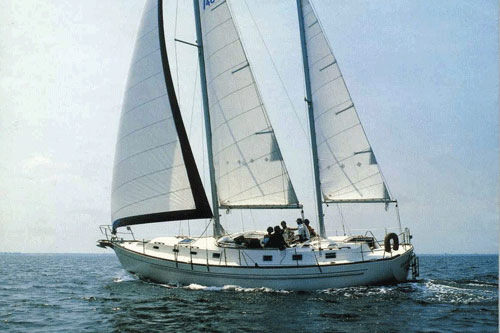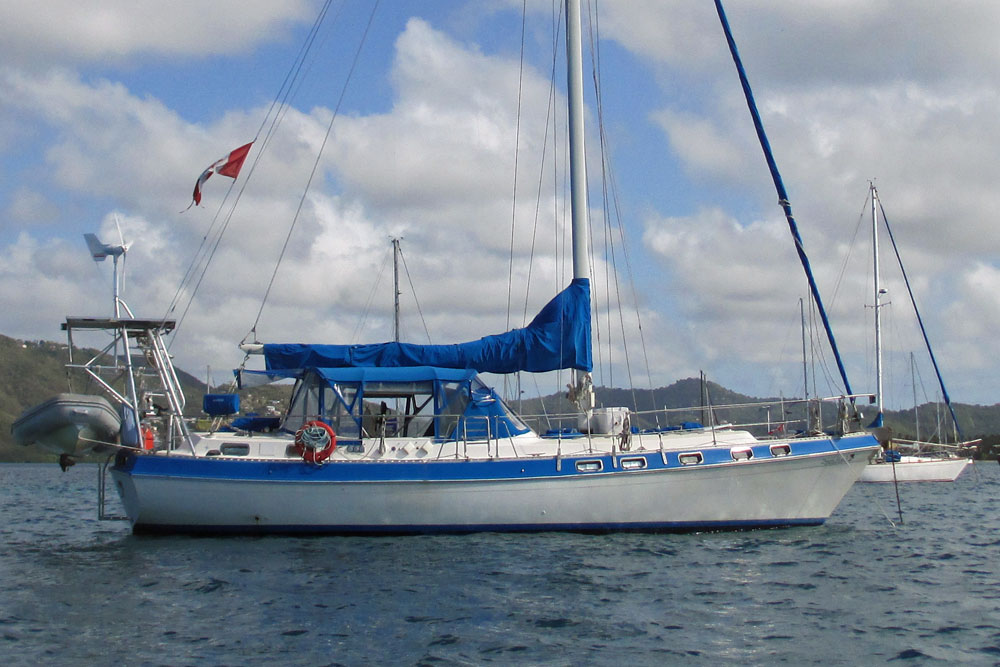- Home
- Cruising Yachts 45' to 50'
- Morgan 46
The Morgan 46 Sailboat
Specs & Key Performance Indicators
The Morgan 46, a centre-cockpit ketch, was designed by Henry Scheel and built in the USA by Morgan Yachts.
Published Specification for the Morgan 46
Underwater Configuration: Fin keel with skeg-hung rudder
Hull Material: GRP (Fibreglass)
Length Overall: 46'6" (14.2m)
Waterline Length: 39'3" (12.0m)
Beam: 13'6" (4.1m)
Draft: 5'3" (1.6m)
Rig Type: Ketch
Displacement: 33,000lb (14,969kg)
Designer: Henry Scheel
Builder: Morgan Yachts (US)
Year First Built: 1979
Year Last Built: 1984
Number Built: 162
Owners Association: Morgan Yacht Owners
Published Design Ratios for the Morgan 46
Sail Area/Displacement Ratio: 13.7
Ballast/Displacement Ratio: 25.5
Displacement/Length Ratio: 244
Comfort Ratio: 38.5
Capsize Screening Formula: 1.7
Summary Analysis of the Design Ratios for the Morgan 46
1. A Sail Area/Displacement Ratio of 13.7 suggests that the Morgan 46 will need a stiff breeze to get her going. In light conditions, unless you've got plenty of time on your hands, motor-sailing may be the way to go.
2. A Ballast/Displacement Ratio of 25.5 means that the Morgan 46 will have a tendency to heel excessively in a gust, and she'll need to be reefed early to keep her sailing upright in a moderate breeze.
3. A Displacement/Length Ratio of 244, tells us the Morgan 46 is a moderate displacement cruiser, which means she'll carry all your cruising gear without it having a dramatic effect on her performance. Most of today's sailboats intended for offshore cruising fall into this displacement category.
4. Ted Brewer's Comfort Ratio of 38.5 suggests that crew comfort of a Morgan 46 in a seaway is similar to what you would associate with the motion of a moderate bluewater cruising boat - a predictable and acceptable motion for most seasoned sailors.
5. The Capsize Screening Formula (CSF) of 1.7 tells us that a Morgan 46 would be a safer choice of sailboat for an ocean passage than one with a CSF of more than 2.0.
Article: The Morgan 46 Sailboat
The Morgan 46 was designed by Henry Scheel and Charley Morgan, two renowned naval architects who have created many successful racing and cruising yachts. It was built by Morgan Yachts, a company that has a long history of producing quality boats for the Caribbean charter trade and the offshore sailing market.
The Morgan 46 was introduced in 1979 and was produced until 1985, with several versions and modifications along the way. The boat has a sleek and elegant profile, with a sweeping sheer line, short overhangs and a low-profile coachroof.
The boat has a center cockpit that offers good protection and visibility, and a spacious aft cabin that can be accessed from the cockpit or the main saloon.
Accommodation
The Morgan 46 sailboat offers plenty of cruising comfort for its owners and guests. The boat has a roomy and bright interior, with 14 opening ports and seven opening hatches that provide ventilation and light. The boat has ample storage space in various compartments, cabinets and lockers throughout the boat.
The boat can hold up to 300 gallons of water and 130 gallons of fuel, allowing for long-range cruising.
The boat has an L-shaped galley on the port side of the main saloon, with a three-burner stove with oven, a double sink, a large refrigerator and freezer, and plenty of counter space and drawers. The galley is well-equipped for cooking meals on board or entertaining guests.
The boat has a U-shaped dinette on the starboard side of the main saloon, with a large table that can seat six people comfortably. The table can be lowered to convert the dinette into an extra berth if needed.
The boat has a navigation station on the starboard side of the companionway, with a large chart table, an instrument panel, and a swivel seat. The navigation station is well-placed for communicating with the cockpit or monitoring the boat's systems.
The boat has two heads, one forward and one aft, both with showers and marine toilets. The forward head is shared by the V-berth cabin and the main saloon, while the aft head is ensuite to the aft cabin.
The boat has two cabins, one forward and one aft, both with large double berths that can sleep two people each.
The forward cabin has a V-shaped berth with storage drawers underneath, shelves on both sides, and an overhead hatch.
The aft cabin has an athwartships king-size berth with storage compartments underneath, hanging lockers on both sides, and an opening port on the transom. The aft cabin is spacious enough to dress and move about with ease.
Hull and Deck
The Morgan 46 sailboat has a solid fiberglass hull that is reinforced with longitudinal stringers and transverse frames. The hull is well-built and durable, able to withstand the rigors of offshore sailing or chartering. The hull has a white gelcoat finish that is easy to maintain and repair if needed. The hull has a flared bow that helps to reduce spray and increase buoyancy forward, together with a moderate freeboard that provides good headroom below without compromising performance or aesthetics.
The hull has an external lead keel that is bolted to the hull with stainless steel bolts. The keel is shaped like a modified fin with a bulb at the bottom that lowers the center of gravity and increases stability. The keel also acts as a grounding plate for the electrical system.
The hull has a skeg-hung rudder that is attached to the keel with a stainless steel skeg. The rudder is shaped like a spade with a balanced section that reduces drag and improves steering response. The rudder is controlled by a single wheel in the cockpit, connected to the rudder post by a cable and pulley system. The rudder also has an emergency tiller that can be fitted to the rudder post if needed.
The deck is made of fiberglass with a balsa core that provides stiffness and insulation. The deck is bonded to the hull with fiberglass and mechanical fasteners, creating a strong and watertight joint.
The deck has a molded nonskid surface that provides good traction and safety, and has a white gelcoat finish that matches the hull and is easy to clean and repair if needed. The deck has a low-profile coachroof that blends well with the hull and does not interfere with the visibility or the airflow. The coachroof has several opening hatches and ports that provide light and ventilation to the interior. The coachroof also has handrails on both sides that provide security when moving forward or aft.
The deck has wide side decks that allow easy access to the bow or the stern. The side decks have raised bulwarks that provide protection from waves and spray. The side decks also have aluminum toerails that serve as attachment points for lifelines, stanchions, cleats, and other hardware. The deck has a large foredeck that can accommodate a windlass, an anchor locker, and a bow roller. The foredeck also has enough space for sunbathing or stowing a dinghy if needed.
The deck has a spacious center cockpit that offers good protection and visibility for the crew. The cockpit has high coamings that keep out water and wind. The cockpit also has deep lockers on both sides that provide storage for sails, lines, fenders, and other gear. The cockpit has a pedestal with a single wheel, a compass, and an instrument pod. The cockpit also has a folding table that can be used for dining or charting. The cockpit has cushioned seats on both sides that can seat six people comfortably. The cockpit also has an access hatch to the aft cabin on the port side, and an engine room hatch on the starboard side.
The deck has a wide transom that provides easy access to the water or the dinghy davits. The transom has an opening port that provides light and ventilation to the aft cabin. The transom also has a swim ladder that can be deployed or stowed as needed.
Mast and Rigging
The Morgan 46 sailboat is available as a sloop or ketch. The mast is made of aluminum and is deck-stepped on a compression post that transfers the load to the keel. The mast is supported by stainless steel wire standing rigging, including upper and lower shrouds, intermediate shrouds, forward and aft lower shrouds, forestay, backstay, and running backstays. The mast also has internal halyards for the mainsail, genoa, staysail, and spinnaker.
The boom is made of aluminum and is attached to the mast with a gooseneck fitting. The boom has an outhaul for adjusting the mainsail shape, and two reefing lines for reefing the mainsail from the cockpit. The boom also has a rigid vang that supports the boom and controls its angle. The boom also has lazy jacks that help to flake the mainsail when lowering it.
The Morgan 46 sailboat can carry a variety of sails, depending on the wind conditions and the sailing preferences of the owner. The boat comes standard with a roller-furling genoa on the forestay, which can be easily reefed or furled from the cockpit.
The boat also comes standard with a fully battened mainsail on the mast, which can be reefed or furled from the cockpit using the in-mast system. The boat also comes standard with a spinnaker on a spinnaker pole, which can be used for downwind sailing or reaching in light winds.
Keel and Rudder
The Morgan 46 sailboat has a modified-fin keel with 6 feet of draft and 6 tons of ballast. The lead fin keel provides good performance and stability for the boat, especially in strong winds and rough seas, and also allows the boat to point well to windward and tack easily.
The keel has a moderate draft that enables the boat to access shallow waters and anchorages. The skeg-hung rudder also has an emergency tiller that can be fitted to the rudder post if needed. The skeg protects it from damage and fouling by debris or marine growth, and also adds strength and stiffness to the rudder and prevents it from fluttering or vibrating at high speeds.
This article was written with the assistance of Gemini, a large language model developed by Google. Gemini was used to gather information, summarize research findings, and provide suggestions for the content and structure of the article.
Other sailboats in the Morgan range include:
Recent Articles
-
Anchors and Anchoring: Your Questions Answered...
Apr 07, 25 05:05 AM
Got a quey about Anchors and Anchoring? Odds are, you'll find the answer here,,, -
Watchkeeping Duties at Sea
Apr 06, 25 08:02 AM
Got a question about watchkeeping duties at sea? Odds are you'll find the answer here... -
The Marine AIS System
Apr 03, 25 09:30 AM
What si the Marine AIS System is, how does it work and what can it do for us sailors?















